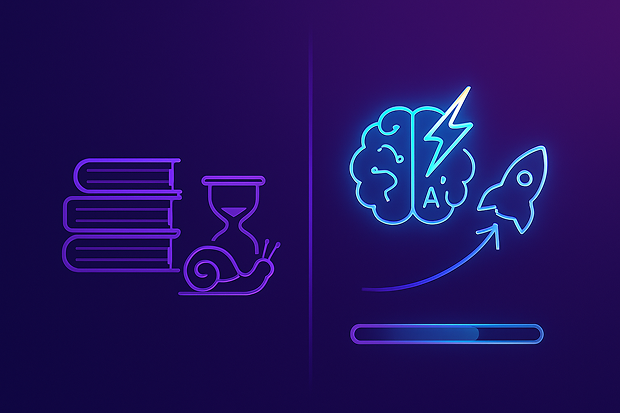In today's fast-paced business world, terms like Artificial Intelligence (AI), Generative Artificial Intelligence (GenAI), and Meeting Summarization are more than just buzzwords – they're shaping how we work, especially in customer-facing interactions. As AI continues to revolutionize everything from sales calls to client briefings, understanding this evolving terminology is crucial for staying ahead.
At FlashIQ, we believe that clarity empowers productivity. That's why we've created this comprehensive glossary: to break down the complex jargon surrounding AI in business, clarify essential meeting concepts, and shed light on the tools that are redefining modern work. Whether you're grappling with Action Item Extraction, curious about Conversational AI, or simply looking to optimize your Meeting Workflow, this resource is designed to be your go-to guide.
Dive in to expand your knowledge and unlock the full potential of intelligent meeting management.
Category 1: Artificial Intelligence (AI) Core Concepts
- Artificial Intelligence (AI): Broad definition of AI and its relevance in modern business.
- Machine Learning (ML): Subset of AI, how systems learn from data.
- Natural Language Processing (NLP): How computers understand, interpret, and generate human language
- Generative AI: AI that creates new content (e.g., generating summaries).
- Deep Learning: Advanced ML, using neural networks.
- Neural Network: The computational model inspired by the human brain, used in deep learning.
- AI Model: The trained algorithm that performs a specific task.
- Algorithm: A set of rules or instructions followed by a computer.
- Data Annotation / Data Labeling: Process of labeling data for AI training.
- Bias (in AI): Unfair outcomes in AI due to skewed training data.
- Confidence Score (AI): AI model's certainty level for an output.
- Conversational AI: AI that simulates human conversation (e.g., chatbots, voice assistants).
- AI-powered Automation / Intelligent Automation: AI enhancing rules-based automation.
- Ethical AI: Principles for responsible AI development and use.
Category 2: AI in Meetings
- AI Meeting Assistant: Supporting a person in a call to success with their objective e.g., by providing real-time answers to customer questions like FlashIQ does.
- Real-time Transcription: Live conversion of speech to text during a meeting.
- Meeting Summarization (AI-generated): AI creating concise overviews of meeting content.
- Question Summarization (AI-generated): Generates customer questions from speech for automated prompting.
- Action Item Extraction / AI Action Item Detection: AI identifying tasks and next steps.
- Speaker Identification: AI distinguishing between different speakers.
- Timestamping: Marking specific moments in a recording or transcript.
- Sentiment Analysis (Meeting): AI analyzing the emotional tone of discussions.
- Meeting Analytics: Data and insights derived from meeting content (e.g., talk time).
- Integration (Software): Connecting solution with other tools (e.g., CRM, project management).
- Note-taking Automation: Automated creation of meeting notes.
- Key Takeaways (AI): AI identifying the most important points.
- Searchable Transcripts: Ability to search through meeting recordings via text.
- Meeting Insights: Actionable intelligence derived from meeting data.
- Follow-up Automation: AI assisting with post-meeting tasks.
- Conversation Intelligence: AI analyzing conversations for business insights.
- Topic Detection (AI): AI identifying the main subjects discussed.
- Voice Recognition: Technology that identifies the speaker based on their voice.
- Voice-activated Intelligence: Technology that allows to set rules or prompts to activate actions based on voice.
Category 3: General Meeting & Productivity Concepts
- Meeting Agenda: A plan for meeting topics.
- Meeting Minutes: Official written record of a meeting.
- Action Item: A task assigned during a meeting.
- Decision-Making (Meetings): The process of concluding on a course of action.
- Productivity Tools: Software designed to enhance efficiency.
- Workflow Optimization: Streamlining processes for better efficiency.
- Asynchronous Communication / Asynchronous Collaboration: Communication not happening in real-time.
- Synchronous Communication / Synchronous Collaboration: Real-time communication (like live meetings).
- Virtual Meeting / Online Meeting: Meetings conducted remotely via the internet.
- Hybrid Meeting: Meetings with both in-person and remote participants.
- Meeting Etiquette: Rules for polite and productive meeting behavior.
- Return on Meeting Investment (ROMI / ROTI): Measuring the value of time spent in meetings.
- Time Management: Strategies for effective use of time.
- Distraction Management: Techniques to avoid interruptions.
- Collaboration Platform: Tools that facilitate teamwork (e.g., Slack, Microsoft Teams).
- Knowledge Management: Organizing and sharing information within an organization.
- Information Overload: Being overwhelmed by too much information.
- Accountability (Meetings): Ensuring tasks and decisions are followed through.
- Knowledge Base:
Category 4: Business & Industry Context
- CRM (Customer Relationship Management): Software for managing customer interactions.
- Project Management Software: Tools for planning and executing projects.
- Sales Enablement: Providing sales teams with resources to close deals.
- Customer Success: Ensuring customers achieve their desired outcomes using a product.
- Remote Work / Distributed Team: Employees working outside a central office.
- Scalability: Ability of a system or process to handle increased workload.
- Compliance (Meeting Records): Adhering to regulations for meeting documentation.
- GDPR / Data Privacy: Regulations concerning data protection (important for transcripts).
Ready to see how AI-powered clarity transforms your customer meetings?

